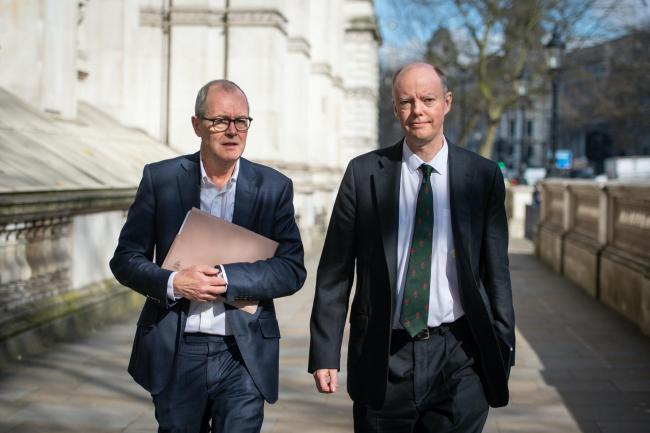By Brandon Anderton-
Chief scientific adviser Sir Patrick Vallance and chief medical officer for England Professor Chris Whitty were accused of frightening the public on projected COVID-19 death figures. The pair were challenged about the evidence behind the lockdown when they appeared before MPs .
A particular modelling scenario used which suggested there could be as many as 4,000 deaths a day did not go down well with Labour MP Graham Stringer, who conducted the grilling. Government scientists on the British government’s Sage group have previously been accused of plucking high numbers of projected deaths arising from COVID-19, if the government fails to act in imposing a lockdown, or a circuit break.
Former Sage member, Professor Neil Ferguson has in particular come under fire from critics for being to quick to make wild predictions relating to deaths related to COVID-19. Some members of The Eye Of Media’s thinktank recently raised alarm with the regularity of Neil Ferguson’s appearance on BBC Radio 4 in making wild projections of deaths, despite a history of wildly inaccurate predictions in the past. The modelling made by Professor Whitty and Vallance are already revealing their wide margins of error, but the eminent scientists explained the basis of their predictions.
Sir Patrick Vallance was humbly apologetic for any misunderstanding as a result of his projections
Labour MP Graham Stringer suggested to Sir Patrick that he had “frightened a lot of people around the country”.
Sir Patrick told the Science and Technology Committee: “I think I positioned that – and if that didn’t come across then I regret that – but I positioned that as a scenario from a couple of weeks ago, based on an assumption to try and get a new reasonable worst-case scenario.”
The experts stressed the importance of six-week projections, rather than the longer-term scenarios.
Sir Patrick said the six-week forward projection suggested the number of people in hospital would pass the first wave “towards the end of November”.
And the number of deaths would equal the first wave “somewhere in mid-December”..
Prof Whitty said that reaching the same levels seen during the peak in April is an “entirely realistic situation”.
He added: “I think there has been some rather overblown rhetoric on this.
Getting to the stage we got to in April – and if we do nothing, carrying on up from there – is entirely realistic
“People can take different projections if they wish.
“But getting to the stage we got to in April – and if we do nothing, carrying on up from there – is entirely realistic.”
Sir Patrick apologised if there was confusion about the different scenarios and projections used at the press conference.
He told MPs: “If this is confusing then I apologise for that, but the model projections of the six weeks were the things that I was clear that ‘that’s what you need to concentrate on’, those are the things that you can have more reliability on in terms of the numbers.
|
“The others were scenarios for reasonable, worst case planning, making an assumption around what the R would be and making an assumption the R may increase over the winter.”
Sir Patrick accepted longer-term modelling, beyond around six weeks, can see some “uncertainty” creep in.
The pair were asked by Tory MP Aaron Bell whether the “avalanche of data” presented on Saturday was “an appropriate way” to make their case to the nation.
Sir Patrick told the committee: “I would always like to get things simpler than they were and clearer than they were.“ That would always be an aim and clearly some of those slides were quite complicated, and it is a very complicated thing.”
MPs probing the Government advisers over data came as two conflicting data reports were published.
New data from the Covid Symptom Tracker app, which is run by King’s College London (KCL), suggests there has been a slight drop in new Covid-19 infections across England, Wales and Scotland.
Professor Tim Spector, who leads the app study, said: “The Zoe CSS (Covid Symptom Study) app survey continues to show a plateauing and slight
fall in new cases in England, Wales and Scotland with an R of 1.0.”
But new data from the MRC Biostatistics Unit at the University of Cambridge puts the R number above one in most regions.
The group estimates that the daily number of new infections each day across England is 77,600. The scientists predict the number of deaths each day is likely to be between 380 and 710 by November 14, far less than Professor Vallance and Whitty had suggested
The British Government has published the data behind the slides used at the Downing Street press conference which have drawn much attention.
The documents show the different assumptions made by the models, leading to conflicting conclusions.
Sir Patrick said that a “package of measures” were needed to get the R rate below one.
In relation to religious gatherings and outdoor sports, he told MPs: “The danger in trying to pick apart each one, and when you get down to the ones towards a lower level where you might say, ‘Well, this doesn’t make much of an impact on its own’, is that you keep cutting things off and then you end up with a suboptimal package.”

